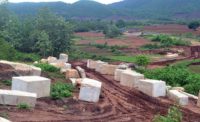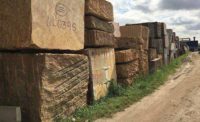
Italian sculptor Simona Bocchi recently spent a full year in India to explore the use of native materials with regard to stone sculpture.
My evolution as an artist, which draws me towards the research, exploration and knowledge of materials - coupled with my endless interest in exploring new places and world cultures - has now brought me to the East. A meeting with the Italian Ambassador in India, Antonio Armellini, and the invitation to exhibit my work at the Italian Embassy in New Delhi in February 2009, have been the catalyst for a greater project: a year-long experience in India.
This decision to work in India was brought on by a deep interest and enthusiasm that’s always connected me to the Indian world. I was seduced by the prospect of taking an unknown journey to further my craft, entwined with the spiritual essence of a mystical place like India. I imagined India, known as a highly expressive and contradictory land, treating me to unique sights from distinct pulsating colors, to architectural and sculptural wonders, to more severe images of the everyday fight for survival.
Travel to India
My ambitious project was made possible and carried out thanks to a meeting with Sakandar Singh, a representative of Harbhajan Marble in Udaipur, India, managed by his brother Rimpu. Unfortunately, the beginning of my working period was considerably delayed due to unforeseen difficulties dealing with Indian laws regarding the shipment of my tools to India. Indian Customs actually held the case containing all of my sculpting equipment for two months. When they did allow my tools to be released, a considerable clearance tax was requested.
In the meantime, I had the chance to breathe a pleasant return to the traditional styles of sculptural work. By rediscovering purely hand-working methods, I felt taken back in time. I thought of Michelangelo Buonarrotti’s writings and how they described the use of the marble blocks to carve David. The hand stone-carving tradition is especially strong in Rajasthan. Wherever you turn, you can admire highly refined sculptures. Hand chiseling enabled me to appreciate the slow progression of work again; something you can miss out on nowadays with the use of technical machinery. In fact, there isn’t a wide range of mechanical equipment available in India but, despite this, the level of technical expertise in marble carving is high.

One of Bocchi’s projects was a sculpture of the principal at Harbhajan Marble, which sponsored the sculptor in India.
In India, you will find an incredible amount of highly colored marble materials of different textures. Many seem at first to be easily workable, like Italian marble, but then, within the same block, the consistency changes to such an extent that completing the work of art becomes more difficult.
Up to now, the most interesting material I’ve found in India for sculpting purposes is the green and black Pareva marble. Answara is a coarse-grained white marble. Pink Palodha is an interesting marble similar to the Pink Portugal, with grey-black veins on a white background. Makrana is a white marble used for Agra’s Taj Mahal - the “marble poem” par excellence.
Sandstone is another interesting material, both for the color and the texture that brings to mind the desert immediately; that silent, infinite place where all is empty, leaving to time the role of carving shapes through the wind. Even if sandstone is a soft material, diamond disks tend to burn out easily, so I suggest using Indian marble disks.
Due to India’s mentality, it is very unusual to see a woman working in marble. During the first days at the factory, where the majority of workers are male, there was great curiosity in seeing me working with all these bizarre machines that hardly anybody had ever seen before.
There are other things to take into consideration when working in India. Cost of labor is very inexpensive so they considered it reasonable for an assistant to do the work for me. It was quite difficult for me to explain that this was my passion, and that nobody could take my place because my creations evolved as time went by. The work pace is so different from Western rhythms. For example, sometimes power can be cut off for hours, without a fixed time schedule or length. When this happens, you just have to stop and wait, and nobody knows for how long.

“Hand chiseling enabled me to appreciate the slow progression of work again; something you can miss out on nowadays with the use of technical machinery,” Bocchi said.
Compared to my Norway work experience, where I took part at the Sculpture Symposium in Os during June 2007, my work in India has been focused on researching unknown materials and experimenting, which requires a considerable amount of time. This exploration can appear to seemingly lead nowhere at times, but it does produce incalculably enriching results. The Symposium’s fixed time schedule makes you cut time down to achieve maximum performance. Creations are monumental, so it is very important to program work well ahead of time.
In India, all is diluted and slowed down. The flow of time is devoted to the pleasure of creating in solitude. The most fascinating aspect of the Symposium in Norway was working and living with many other artists. We were able to share each other’s frame of mind, watch each work of art being created, and share its progress. Artists from all over the world meet for this conference to blend traditions, cultures, techniques, moods - and most of all, the same passion for sculpture.
Meanwhile, in Italy, we not only have some of the world’s best marble quarries - those of well-known statuary marble and Bianco Carrara P, which are extremely pure, compact materials - we also have unique and marvelous scenery that would enchant any visitor. Each country holds a unique charm for me. They always inspire in me new and different ways that meld together to form one sole truth. This love I have for materials surprises me every time.
I recommend that every artist experience something like what I’m now living in India. Art is an expression without a single home; an expression that comes from the heart is freedom’s only source, and it is that display of the divine that lives in each one of us.
About Harbhajan Marble
Harbhajan Marble owns two marble quarries in Italy and one in Greece. In Italy, the company extracts Botticini (in Brescia) and Perlatino (in Trapani, Sicily). Both materials are exported worldwide, and they are used by the interior design community in India. The company’s quarry in Greece exports white marble to India.
Harbhajan Marble works in a range of unique materials, including materials such as Tiger’s Eye, Lapis Lazuli and petrified wood - among other exotic stones from locales around the world - as well as precious stones quarried in India.
“We are honored to work with Simona Bocchi on her creative journey to India. This relationship has greatly enhanced our experience in the marble industry and has motivated us to expand our participation in it,” stated Sakandar Singh. “I hope more companies will choose to be involved in supporting art worldwide, and that the dialogue between enterprise and creative mind remains alive.”

